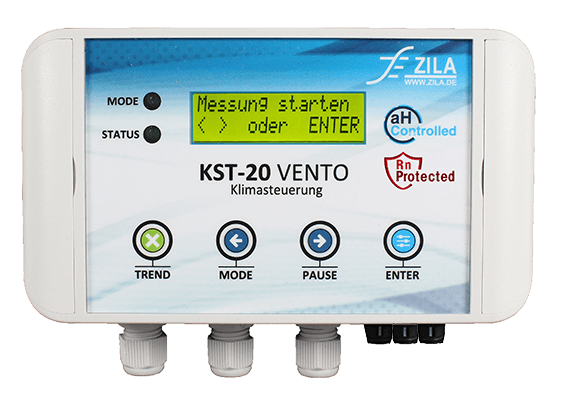
- Written by ZILA GmbH
- font size decrease font size increase font size
Radon ventilation with our KST-20 Vento/RN
Health risks
People are exposed to natural radiation. The majority of this is radon, followed by terrestrial and cosmic radiation and radiation from construction materials. Medical check-ups and people themselves also emit radiation. This natural radiation is considered harmless. Radon, however, is a gas whose isotopes can be dangerous for humans.

Long-term exposure to an increased radon concentration also implies a higher risk of cancer. It is assumed that the risk of lung cancer per 100 Bq/m³ rises by up to 16%. Radon is also the second most frequent cause of lung cancer, directly after smoking. Only in Germany, about 5% of all lung cancer cases result from radon. Radon is estimated to cause 1900 deaths per year. Especially smokers have a 25 % higher cancer risk than non-smokers when they are in permanent contact with radon.
Already in 1988, the World Health Organization (WHO) classified radon as a "substance carcinogenic to humans". This finding is based on an epidemiological study of miners in the 1960s. Today we know that radon can also reach the earth's surface and that even the smallest amounts are dangerous over a long period of time.
However, the dangerous radioactive radiation is not caused by radon itself, but by its decay products. As radon is a gas, it can easily be in- or exhaled. The isotopes of lead, polonium and bismuth however are heavy metals. These are able to bind with other substances, such as dust and water molecules. Thus, the radioactive secondary products may enter the human organism by breathing and also settle there, which can damage the upper cell layers of the lungs and airways. The result, if persistently exposed to a high radon level, is lung cancer. In rare cases, the ear, nose and throat ares as well as the skin can also be affected. However, this requires an extremely high exposure.
Ventilation as an efficient way in order to reduce the radon concentration
Since radon is a gas and can accumulate in cellars, ventilation is an effective way to minimise the concentration. In this way, the danger of the radioactive decay products can be reduced before it even exists. The air exchange ensures that radon can be removed from building afffected. Besides, cellar ventilation also generates an overpressure, which reduces the gas' extraction from the ground.
Long-term measurements have proven that ventilation is a key factor in reducing the radon concentration in buildings. Using control systems is therefore highly recommendable. In this way, the radon concentration is monitored user-independently and can be reduced by automatically by starting the ventilation process. Since radon mainly occurs in cellars, ground level or basement rooms, most of these rooms are also exposed to increased humidity. It can generally be assumed that humidity in basement rooms also may be an indication for a potential radon exporsure.
Damp walls or floors are an indication for leaks and cracks in the brickwork or substrate, what may also allows radon to enter the interior of the building. In fact, there is no direct connection between moisture and radon. However, both of them are caused by leaking foundations. Since moisture is the most common cause of condensation water or mould growth, this problem will be counteracted at the same time. Thanks to its innovative technology, our climate controller KST-20 Vento/RN is able to measure both the absolute humidity and the radon concentration in the room. Thus, a constant healthy room climate, preventing mould growth, is achieved.
We will be pleased to offer you the appropriate set for your application. If you focus on an easy and comfortable handling and would like to adjust the parameters of the controller, please ask for an individual quote for our climate controller KST-20 Vento/RN. Depending on the size of your room(s) (volume), we can also provide you with additional or larger fans. The cable length of the indoor sensor can be ordered in the standard sizes of 2,5m, 5m and 10m. Should you already have fans or other actuators in your cellar, we can also customise the control unit for your specific requirements.
The KST-20 Vento/RN

Technical data
- Measuring range humidity: 0…100 % rH
- Measuring range temperature: -40…+80 °C
- Measuring range radon: 0…1200 Bq/m³
- Adjustable radon limits: 80…100 Bq/m³
Features
- Flexibly adjustable radon limit values
- Controlled ventilation when exceeding these radon limits
- Room dehumidification based on the absolute humidity
- Protection against room dehydration: Drying protection
- Protection against rapid room cooling: Frost protection
- Time switch with active and passive times
Further information on our climate control KST-20 Vento/RN are linked below:
KST-20 Vento with radon ventilation
Blog post part 1: Health risks of radon and limit values
Blog post part 2: Radon inside the house, in the cellar or basement
